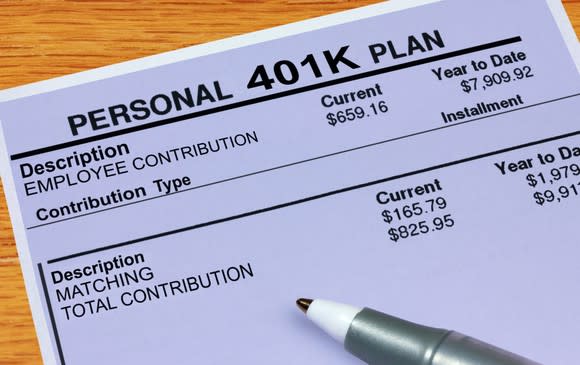Your 401(k) Vesting Schedule: What You Need to Know
If you're fortunate enough to have access to a 401(k) plan at work, chances are, you're also eligible for some free money, as well. That's because an estimated 92% of companies that offer 401(k)s are also willing to match employee contributions to varying degrees. Your employer, for example, might contribute 3% of your salary to your 401(k), provided you contribute at least that amount yourself.
But before you get used to the idea of having that free money in your account, you'll need to read up on your company's 401(k) vesting schedule. A vesting schedule refers to the amount of time it takes for you to gain complete ownership of assets given to you by an employer -- in this case, 401(k) dollars.

Image source: Getty Images.
For example, your company might impose a three-year vesting schedule, which means you'll need to remain employed for that much time to be fully vested. Fail to meet that requirement, and you'll risk forfeiting a portion (or all) of your balance. On the other hand, once that three-year period is up, your employer won't have the option to take back any of the money it gave you. Knowing how your vesting schedule plays out can help you make smart choices with regard to your 401(k), so be sure to understand what requirements your company puts forth.
Types of vesting schedules
Why do employers impose vesting schedules? It's simple -- they don't want to risk giving you something (in this case, free money for retirement) only to have you up and quit several months later. Think about it: If your employer contributes money to your 401(k), and you get a better job offer immediately thereafter, what's to stop you from taking it? Perhaps nothing -- unless, of course, doing so means forfeiting, say, $3,000 in your 401(k).
That said, not all vesting schedules are created equal. Here are the three types that companies typically employ:
Immediate vesting: This is the kind you want. With immediate vesting, you gain full ownership of your employer's contributions the moment they hit your account.
Cliff vesting: This is the most restrictive type of vesting schedule because under this setup, you get full ownership of your employer's contributions at a specific point in time. However, you don't get partial ownership along the way. This means that if you're looking at a three-year vesting date but leave your job after two years, you forfeit everything your employer has put in thus far.
Graded vesting: This type of vesting is a middle ground of sorts, as it gives you increasing ownership of employer contributions over time until you're 100% vested. For example, if you have a four-year graded vesting schedule and leave your job after two years, you'll get to take 50% of your employer's contributions with you.
Clearly, the type of vesting schedule you have might influence your decision to stay at your job versus leaving it. For example, if you're looking at a three-year vesting date under a cliff arrangement, and you're four months shy of that deadline, you might hesitate to leave your job if waiting a bit longer means getting to keep a chunk of employer-contributed cash. On the other hand, if you're only six months into that three-year period, you might choose to cut your losses and move on.
Keep in mind, however, that vesting schedules don't apply to the money you contribute to your 401(k) yourself. Any funds withheld from your paychecks are yours to keep no matter when you leave your job. Or to put it another way, you become 100% vested in your own contributions the moment they hit your account.
Remember, in some cases, it might actually pay to forgo some free money in your 401(k) if doing so opens the door to better opportunities. For example, if you're offered a job with a $5,000 salary boost and a far more generous 401(k) match, it might pay to give up $1,000 in employer-contributed dollars. The key is to familiarize yourself with your company's vesting schedule so you can be as strategic as possible with regard to your 401(k).
More From The Motley Fool
The Motley Fool has a disclosure policy.

 Yahoo Finance
Yahoo Finance 